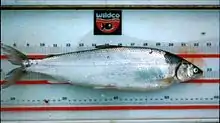Arctic cisco
Arctic cisco (Coregonus autumnalis), also known as omul Russian: Омуль, is an anadromous species of freshwater whitefish that inhabits the Arctic parts of Siberia, Alaska and Canada. It has a close freshwater relative in several lakes of Ireland, known as the pollan, alternatively regarded as conspecific with it, or as a distinct species.[2][3]
| Arctic cisco | |
|---|---|
 | |
| Scientific classification | |
| Domain: | Eukaryota |
| Kingdom: | Animalia |
| Phylum: | Chordata |
| Class: | Actinopterygii |
| Order: | Salmoniformes |
| Family: | Salmonidae |
| Genus: | Coregonus |
| Species: | C. autumnalis |
| Binomial name | |
| Coregonus autumnalis (Pallas, 1776) | |
Taxonomy
The freshwater omul of Lake Baikal, formerly considered a subspecies Coregonus autumnalis migratorius of the Arctic cisco, has no close genetic relationship to it and is now classified as a separate species, Coregonus migratorius.[4][5]
Description
The Arctic cisco have a relatively small head with a non-prominent snout. They have metallic silver body, a brown or dark green back, and nearly colorless fins. They have neither spots nor teeth on their jaws. They do have a patch of teeth on their tongue. They can reach 50 cm (20 in) in length and can weight up to 2 kg (4.4 lbs), but are usually less than 40 cm (16 in) in length and 1 kg (2.2 lbs) in weight.[6][7]
Distribution and habitat
Arctic cisco can be found in the Beaufort Sea, Colville River delta, and freshwater drainages east of the Sagavanirktok River. They can be found in several drainages in the Northwest Territories and Siberia, such as the Chaun River, and are not often found east of Point Barrow.
Food chain
Diet
The Arctic cisco preys upon plankton, crustaceans, and small fishes.[6]
Predators
Predators of the Arctic cisco include marine mammals, seabirds, and large fishes such as the Dolly Varden trout and burbot.[6]
Behaviors
Reproduction
Arctic cisco are able to spawn at 8 or 9 years of age. Females may only be able to spawn two or three times in their life, and do not necessarily produce eggs every year.
The Arctic cisco reproduce in September. They do not reproduce in Alaskan waters, but do reproduce in Mackenzie River.
Females have up to 90,000 eggs.[6]
Life history
Arctic cisco can live to be 13 years old or more.[6]
Conservation
Little is known of the abundance of the Arctic cisco in Alaska.[6]
Threats
The largest threats to the Arctic cisco appear to be climate change and oil and gas development.[6]
References
- Freyhof, J.; Kottelat, M. (2008). "Coregonus autumnalis". IUCN Red List of Threatened Species. 2008: e.T5363A11123479. doi:10.2305/IUCN.UK.2008.RLTS.T5363A11123479.en. Retrieved 19 November 2021.
- Froese, Rainer; Pauly, Daniel (eds.) (2010). "Coregonus autumnalis" in FishBase. 04 2010 version.
- Froese, Rainer; Pauly, Daniel (eds.) (2010). "Coregonus pollan" in FishBase. 04 2010 version.
- Froese, Rainer; Pauly, Daniel (eds.) (2010). "Coregonus migratorius" in FishBase. 04 2010 version.
- Freyhof, J.; Kottelat, M. (2008). "Coregonus autumnalis". IUCN Red List of Threatened Species. 2008: e.T5363A11123479. doi:10.2305/IUCN.UK.2008.RLTS.T5363A11123479.en.
- "Arctic Cisco Species Profile, Alaska Department of Fish and Game". Alaska Department of Fish and Game. Retrieved 2018-11-23.
- "Marine Species Identification Portal: Arctic cisco - Coregonus autumnalis". species-identification.org. Retrieved 2018-11-23.
